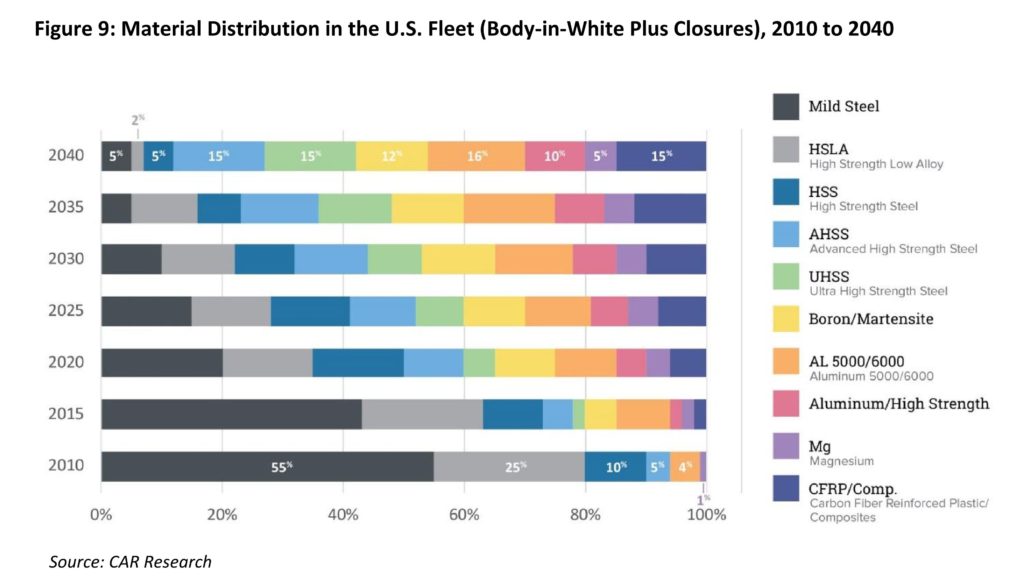
CAR whitepaper predicts future of body materials: Everything but mild steel
By onAssociations | Business Practices | Education | Market Trends | Repair Operations | Technology
Trying to plan what materials you’ll need to know over the next two decades of auto body repair? A new Center for Automotive Research white paper suggests it really could be all of them — but with very little of the weaker steels which made for decades of easy and familiar auto body repairs.
In fact, CAR projects that the U.S. fleet of 2040 will have a smaller percentage of lower-tier steels (mild steel; high-strength, low-alloy; and high-strength steel) than it will have of carbon fiber and other composites.
In 2010, 55 percent of the American fleet was mild steel, that staple 270-megapascal stuff that can be easily manipulated by a body shop, according to the think tank. Another 35 percent was high-strength, low-alloy or high-strength steels, still below 590-megapascal advanced high strength steel and facing little, if any, restriction on repairability. (For example, see the General Motors and Honda steel guidelines.)
The rest of the car was 5 percent advanced high-strength steels, 4 percent aluminum, and 1 percent magnesium. Only a tenth of the body required special repair considerations or had restrictions, give or take. (The average repairable vehicle is about 6-7 years old, so that 2010 mix of materials should be coming through the door today.)
By 2040, guess what? CAR projects only about a tenth of the fleet’s bodies, 12 percent, will be restriction-free mild- to high-strength steel. The other 42 percentage points worth of steel found on vehicles will be advanced high-strength steel or even more restrictive ultra-high-strength and boron/martensite steel — which can mean more replace-only parts.

“Hot forming of steels is already used in high production parts and will reach maturity by 2025 as the need for ultra-high strength steels increases,” CAR wrote. “… Maturity of a technology is a subjective term which depends on the vehicle program. In broad terms, a mature technology can be used in mass-produced vehicles (volume over 100,000 units a year), has multiple product applications, and is available from multiple suppliers with a global supply capability.”
What will the other 46 percent of the car be made of? 26 percent will be aluminum, including what CAR describes as “high strength” aluminum. Only about 5 percent will be magnesium, a stat which stays fairly consistent since around 2020-2025. The final 15 percent will be carbon fiber or other composites.
“Experts agree that no single material wins in the race to lightweighting,” CAR wrote in a passage accompanying this chart. “A weight and performance optimized vehicle will have a mixed-material body structure. The industry is already experiencing this shift in recently introduced vehicles which use materials customized for each area of the car to simultaneously advance driving dynamics, fuel economy, and cabin quietness.”
Based on CAR’s projections, it seems as though shops (and techs?) which decided to write off the prospect of future F-150 work to avoid having to buy dedicated aluminum tooling, space and training might have just delayed the inevitable. (And technically, you might need that stuff for work on items like aluminum hoods and bumpers on an otherwise steel car.) CAR’s projections show a fairly steady rise in aluminum starting about 2020 until the 26 percent estimate for 2040.
While you’re prepping for the future, it can’t hurt to bone up on advanced joining techniques. CAR predicts resistance spot welding will fall from around 75 percent of factory joining today to about 20 percent by 2030, with adhesive, pre-tailored blanks (a part comprised of multiple elements and materials joined together and delivered to an OEM in a single piece), and rivets gobbling up its market share.

While not every factory technique translates to a similar repair in the aftermarket, a shop might be doing less welding and replacing more parts than in the past.
“With new materials come new challenges,” CAR wrote. “Joining dissimilar materials is not easy, and is sometimes impossible to do using traditional resistance spot welding due to differences in melting point. Joining technologies–such as adhesives and advanced fasteners–will play an important role in achieving the optimized mixed-material architecture, since they have the ability to join any combination of dissimilar materials.”
As noted earlier, no matter what the Trump administration does regarding emissions and fuel economy, these lightweighting trends should endure. OEMs will have to sell similar vehicles in other countries which are likely to require cleaner cars — and subsequently spur weight reduction. And as vehicles become smarter and more comfortable, they add weight that must be offset.
CAR estimated that by 2025, each car will have added 5 percent of its curb weight in “safety and performance improvements.”
“For example, an additional 200 to 300 pounds per vehicle will be added for automated driving features,” CAR continued.
CAR’s study is free, and collision repair professionals should avail themselves of the opportunity to ponder the predictions and what they could mean for one’s own business or career over the next 20 years. The whitepaper also contains predictions on mobility and the powertrain which might be useful as well. Other free CAR research can be found here.
More information:
Center for Automotive Research, June 2017
Center for Automotive Research publications
Images:
Various metals, including aluminum green), magnesium yellow), and press-hardened ultra-high-strength steel (maroon) can be seen on the 2017 Chrysler Pacifica at NACE 2016. Also visible is the composite front structure (red). (John Huetter/Repairer Driven News)
The Center for Automotive Research projects that the U.S. fleet of 2040 will have a smaller percentage of lower-tier steels (mild steel; high-strength, low-alloy; and high-strength steel) than it will have of carbon fiber and other composites. (Provided by Center for Automotive Research)
Potential future manufacturing techniques, according to the Center for Automotive Research. (Provided by Center for Automotive Research)
